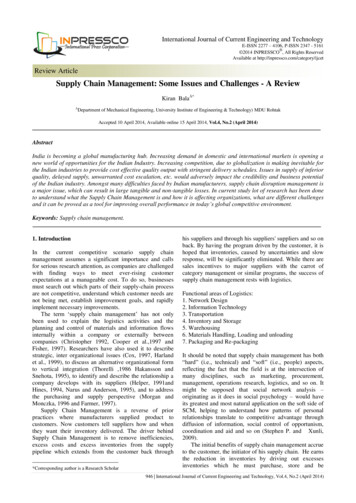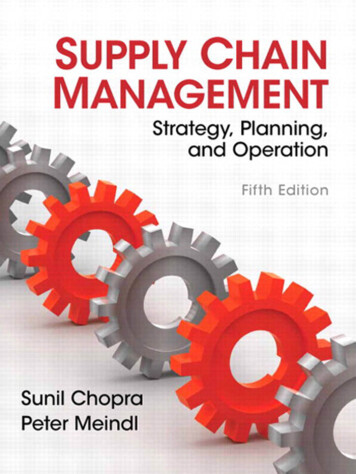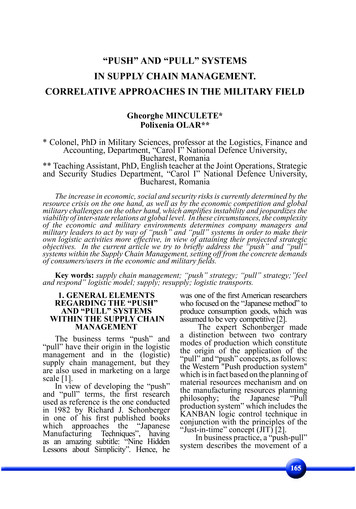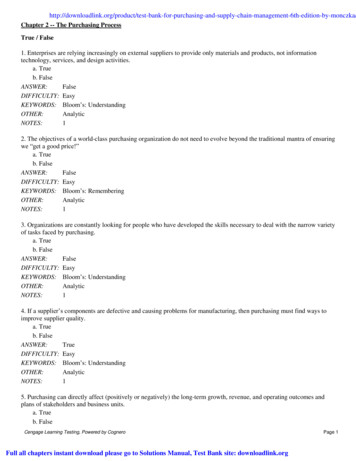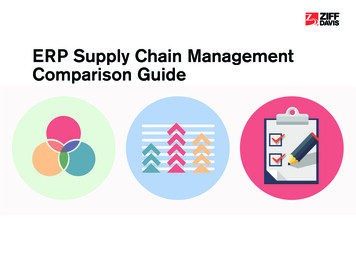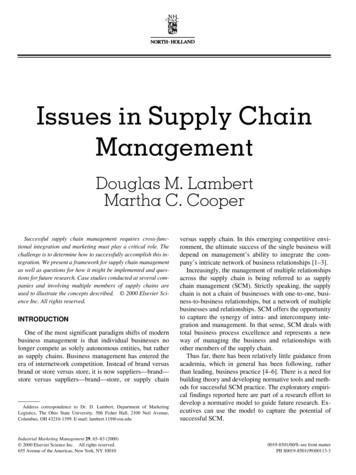
Transcription
Issues in Supply ChainManagementDouglas M. LambertMartha C. CooperSuccessful supply chain management requires cross-functional integration and marketing must play a critical role. Thechallenge is to determine how to successfully accomplish this integration. We present a framework for supply chain managementas well as questions for how it might be implemented and questions for future research. Case studies conducted at several companies and involving multiple members of supply chains areused to illustrate the concepts described. 2000 Elsevier Science Inc. All rights reserved.INTRODUCTIONOne of the most significant paradigm shifts of modernbusiness management is that individual businesses nolonger compete as solely autonomous entities, but ratheras supply chains. Business management has entered theera of internetwork competition. Instead of brand versusbrand or store versus store, it is now suppliers—brand—store versus suppliers—brand—store, or supply chainAddress correspondence to Dr. D. Lambert, Department of MarketingLogistics, The Ohio State University, 506 Fisher Hall, 2100 Neil Avenue,Columbus, OH 43210-1399. E-mail: lambert.119@osu.eduIndustrial Marketing Management 29, 65–83 (2000) 2000 Elsevier Science Inc. All rights reserved.655 Avenue of the Americas, New York, NY 10010versus supply chain. In this emerging competitive environment, the ultimate success of the single business willdepend on management’s ability to integrate the company’s intricate network of business relationships [1–3].Increasingly, the management of multiple relationshipsacross the supply chain is being referred to as supplychain management (SCM). Strictly speaking, the supplychain is not a chain of businesses with one-to-one, business-to-business relationships, but a network of multiplebusinesses and relationships. SCM offers the opportunityto capture the synergy of intra- and intercompany integration and management. In that sense, SCM deals withtotal business process excellence and represents a newway of managing the business and relationships withother members of the supply chain.Thus far, there has been relatively little guidance fromacademia, which in general has been following, ratherthan leading, business practice [4–6]. There is a need forbuilding theory and developing normative tools and methods for successful SCM practice. The exploratory empirical findings reported here are part of a research effort todevelop a normative model to guide future research. Executives can use the model to capture the potential ofsuccessful SCM.0019-8501/00/ –see front matterPII S0019-8501(99)00113-3
Supply chain management (SCM) is a newway of managing the business andits relationships.The Global Supply Chain Forum (GSCF), a group ofnon-competing firms and a team of academic researchers, has been meeting regularly for the past 6 years withthe objective to improve the theory and practice of SCM.The definition of SCM as developed and used by TheGSCF is as follows:1Supply Chain Management is the integration of key business processes from end user through original suppliersthat provides products, services, and information that addvalue for customers and other stakeholders.This broader understanding of the SCM concept is illustrated in Figure 1, which depicts a simplified supplychain network structure; the information and productflows; and the key supply chain business processes penetrating functional silos within the company and the vari-ous corporate silos across the supply chain. Thus, business processes become supply chain business processeslinked across intra- and intercompany boundaries.This paper is organized as follows: First, there is abrief literature review relating SCM to logistics and tomarketing channels research. The case methodology thatprovides the basis for our findings is described. Next, wereport some of the findings and key issues related to eachof the three elements of the SCM framework. For simplicity, each element will be dealt with separately; although, in practice, they are closely interrelated. Issuesregarding how to map business processes across the supply chain are briefly described. Finally, suggestions forfuture research and conclusions are outlined [7–9].LITERATURE REVIEW1Previously the Research Roundtable of The International Center forCompetitive Excellence, University of North Florida (UNF), Dr. Douglas M.Lambert, Director, 1994. In 1996, this group moved with Dr. Lambert to TheOhio State University (OSU) and became The Global Supply Chain Forum.Beginning in January 1999, the group is jointly involved with OSU and UNF.DOUGLAS M. LAMBERT is the Raymond E. Mason Professor ofTransportation and Logistics, and Director of The GlobalSupply Chain Forum, Fisher College of Business, The OhioState University. He is also the Prime F. Osborn III EminentScholar Chair in Transportation, Professor of Marketing andLogistics, and Director of The International Center forCompetitive Excellence, University of North Florida,Jacksonville, Florida.MARTHA C. COOPER is Professor of Marketing and Logistics,Fisher College of Business, The Ohio State University. She hasworked in brand management and in sales. Her researchinterests include supply chain management, partnership andother interfirm relationships, the role of customer service incorporate strategy, international logistics, strategic planning forlogistics, and cluster analysis.66SCM has received considerable attention in the popular business press and in some academic literatures. Thissection is divided into two parts. First, the emergence ofSCM from the logistics literature is described. Then, selected marketing literature is related to the SCM concept.SCM versus LogisticsThe term SCM was originally introduced by consultantsin the early 1980s [10] and has subsequently gained tremendous attention [11]. Since the early 1990s, academics haveattempted to give structure to SCM [12–14]. Bechtel and Jayaram [15] identified generic schools of SEM thought andthe major contributions from the literature. They also identified fundamental assumptions of SCM that must be challenged in the future.Until recently, most practitioners [16–20], consultants[21–23], and academics [24–28] had viewed SCM notappreciably different from the contemporary understanding of logistics management, as defined by the Council
Supply chain management: integrating and managing business processes across the supply chain.Source: [7, p. 10]FIGURE 1.of Logistics Management (CLM) in 1986.2 That is, SCMwas viewed as logistics outside the firm to include customers and suppliers. Logistics, as defined by the CLM,always represented a supply chain orientation “frompoint of origin to point of consumption.” Then why theconfusion? It is probably due to the fact that logistics is afunctional silo within companies and is also a bigger concept that deals with the management of material and information flows across the supply chain. This is similarto the confusion over marketing as a concept and marketing as a functional area. Thus the quote from CEO:“Marketing is too important to be left to the marketingdepartment.” Everybody in the company should have acustomer focus. The marketing concept does not apply2In 1986, the Council of Logistics Management, the leading-edge professionalorganization with a current membership of over 15,000, defined logisticsmanagement as: The process of planning, implementing, and controlling theefficient, cost-effective flow and storage of raw materials, in-process inventory,finished goods, and related information flow from point-of-origin to point-ofconsumption for the purpose of conforming to customer requirements. What’s ItAll About? Council of Logistics Management, Oak Brook, Illinois, 1986.just to the marketing department. It is everybody’s responsibility to focus on serving the customer’s needs.The understanding of SCM has been re-conceptualizedfrom integrating logistics across the supply chain to thecurrent understanding of integrating and managing keybusiness processes across the supply chain [5]. Based onthis emerging distinction between SCM and logistics, inOctober 1998 CLM announced a modified definition oflogistics. The modified definition explicitly declaresCLM’s position that logistics management is only a partof SCM. The revised definition is as follows:Logistics is that part of the supply chain process thatplans, implements, and controls the efficient, effectiveflow and storage of goods, services, and related information from the point-of-origin to the point-of-consumptionin order to meet customers’ requirements.3Imagine the degree of complexity required to manageall suppliers back to the point of origin and all products/3Presented at the annual business meeting, Council of LogisticsManagement (CLM), in Anaheim, California, in October 1998. The definitionis posted at the CLM’s homepage at http://www.CLM1.org.67
FIGURE 2.Supply chain network structure. Source: [8, p. 3]services out to the point of consumption. It is probablyeasier to understand why executives would want to manage their supply chains to the point of consumption, because whoever has the relationship with the end user hasthe power in the supply chain. Intel created a relationshipwith the end user by having computer manufacturersplace an “intel inside” label on their computers. This affects the computer manufacturer’s ability to switch microprocessor suppliers. But managing all tier-1 suppliers’networks to the point of origin is an enormous undertaking. Managing the entire supply chain is a very difficultand challenging task, as illustrated in Figure 2.Marketing PerspectiveEarly marketing channel researchers such as Wroe Alderson and Louis P. Bucklin conceptualized the key factors for why and how channels are created and structured[29–31]. From a supply chain standpoint, these researchers were on the right track in the areas of: 1) identifyingwho should be a member of the marketing channel, 2)describing the need for channel coordination, and 3)drawing actual marketing channels. However, for the last30 years many channels researchers ignored two criticalissues. First, they did not build on the early contributions68by including suppliers to the manufacturer and thus neglected the importance of a total supply chain perspective. Second, they focused on marketing activities andflows across the channel and overlooked the need to integrate and manage multiple key processes within andacross companies. More recently, Webster [32] challenged marketers and marketing researchers to considerrelationships with multiple firms. He also called forcross-functional consideration in strategy formulation.Unlike the marketing channels literature, a majorweakness of much of the SCM literature is that the authors appear to assume that everyone knows who is amember of the supply chain. There has been little effortto identify specific supply chain members, key processesthat require integration or what management must do tosuccessfully manage the supply chain.METHODOLOGYIn order to better understand SCM, a case-study approach is used involving the supply chains of members ofThe GSCF. Thus far, over 90 in-depth interviews, in 15companies covering 9 different supply chains, have beenconducted with managers representing various levels,
Managing a supply chain is a difficult task.functions, and processes. The processes covered in theinterviews included customer relationship management,customer service management, demand management, order fulfillment, procurement, and product developmentand commercialization. The functions represented bythose interviewed included marketing/sales, logistics,manufacturing, information systems, finance, qualitymanagement, and strategic planning. The interviewswere conducted using a 36-question interview guide,which was developed based upon our previous work, areview of the literature, and discussions with members ofThe GSCF. The interviews were conducted in person,ranged from 1 to 3 hours, and were recorded and transcribed for analysis.A CONCEPTUAL FRAMEWORK OF SCMThe conceptual framework emphasizes the interrelatednature of SCM and the need to proceed through severalsteps to design and successfully manage a supply chain.The SCM framework consists of three closely interrelated elements: the supply chain network structure, thesupply chain business processes, and the supply chainmanagement components (Figure 3).The supply chain network structure consists of themember firms and the links between these firms. Business processes are the activities that produce a specificoutput of value to the customer. The management components are the managerial variables by which the business processes are integrated and managed across thesupply chain. Each of the three interrelated elements thatconstitute the framework is now described.Supply Chain Network StructureAll firms participate in a supply chain, from the rawmaterials to the ultimate consumer. How much of thissupply chain needs to be managed depends on severalfactors including the complexity of the product, the number of available suppliers, and the availability of raw materials. Dimensions to consider include the length of thesupply chain and the number of suppliers and customers ateach level. It would be rare for a firm to participate in onlyone supply chain. For most manufacturers, the supplychain looks less like a pipeline or chain than an uprootedtree, where the branches and roots are the extensive network of customers and suppliers [33]. The question is howmany of these branches and roots need to be managed.The closeness of the relationship at different points inthe supply chain will differ. Management will need tochoose the level of partnership appropriate for particularsupply chain links [34]. Not all links throughout the supply chain should be closely coordinated and integrated.The most appropriate relationship is the one that best fitsthe specific set of circumstances [35]. Determi
Supply chain management: integrating and managing business processes across the supply chain. Source: [7, p. 10] 2 In 1986, the Council of Logistics Management, the leading-edge professional organization with a current membership of over 15,000, defined logistics management as: The process of planning, implementing, and controlling the

